Laparoscopy Care Management Case Study Review Assignment Task 2
VerifiedAdded on 2022/09/25
|12
|3681
|28
Case Study
AI Summary
This case study reviews the care management of a patient, Nicole, following a laparoscopic appendectomy. It identifies significant post-operative risks, including fluid deficit, infection, and acute pain, and discusses the importance of evidence-based practice in nursing interventions. The assignment emphasizes the use of resources such as NMBA standards, APNA, and AIHW to guide nursing practice and ensure patient-centered care. It explores the nursing scope of practice, highlighting responsibilities in assessment, planning, evaluation, and the influence of nursing leadership on patient outcomes. The study stresses the importance of communication, emotional support, and involvement in the care process to enhance patient safety and quality of care. Furthermore, it underscores the critical role nurses play in monitoring patients post-surgery, managing complications, and advocating for optimal patient recovery.
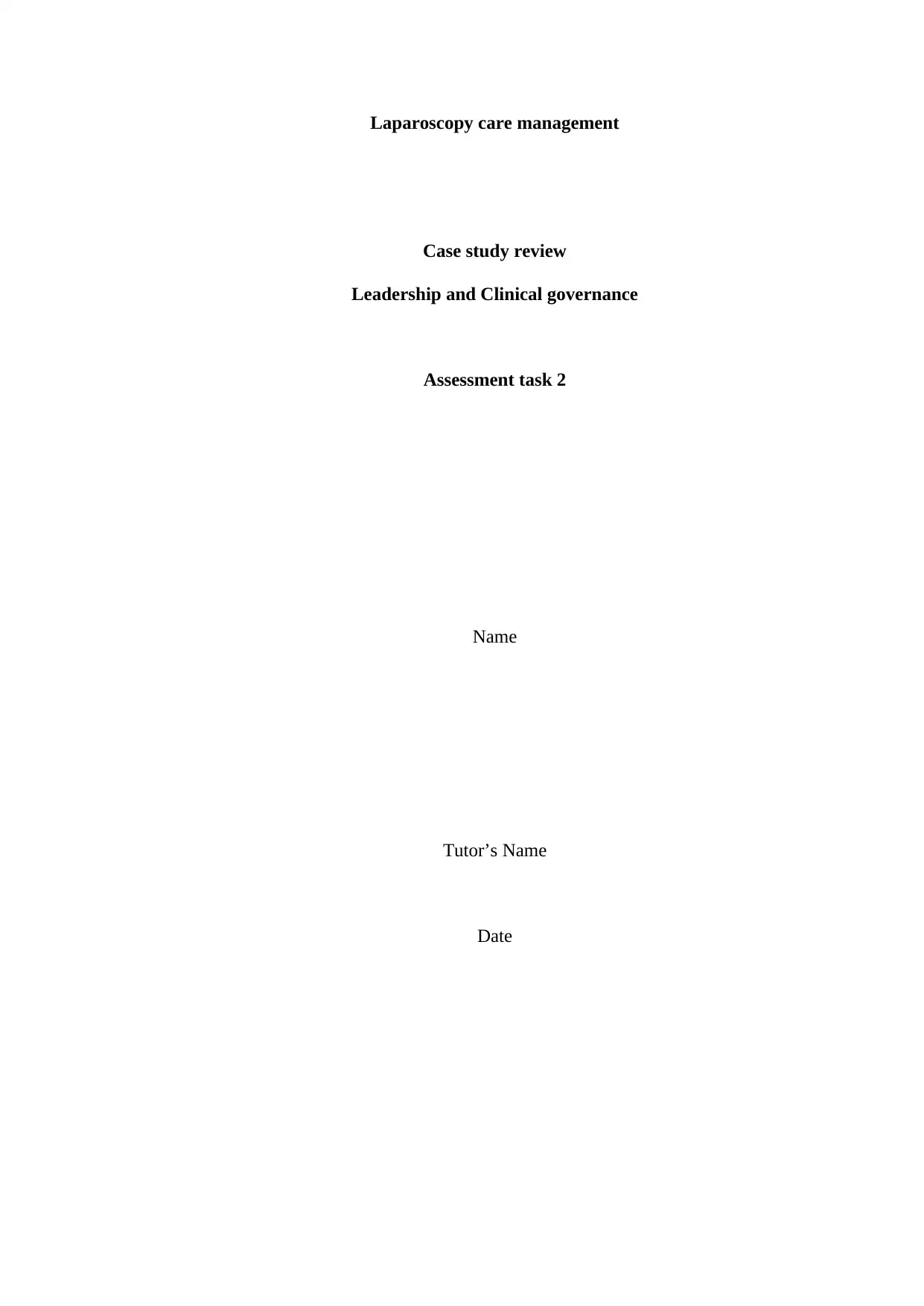
Laparoscopy care management
Case study review
Leadership and Clinical governance
Assessment task 2
Name
Tutor’s Name
Date
Case study review
Leadership and Clinical governance
Assessment task 2
Name
Tutor’s Name
Date
Paraphrase This Document
Need a fresh take? Get an instant paraphrase of this document with our AI Paraphraser
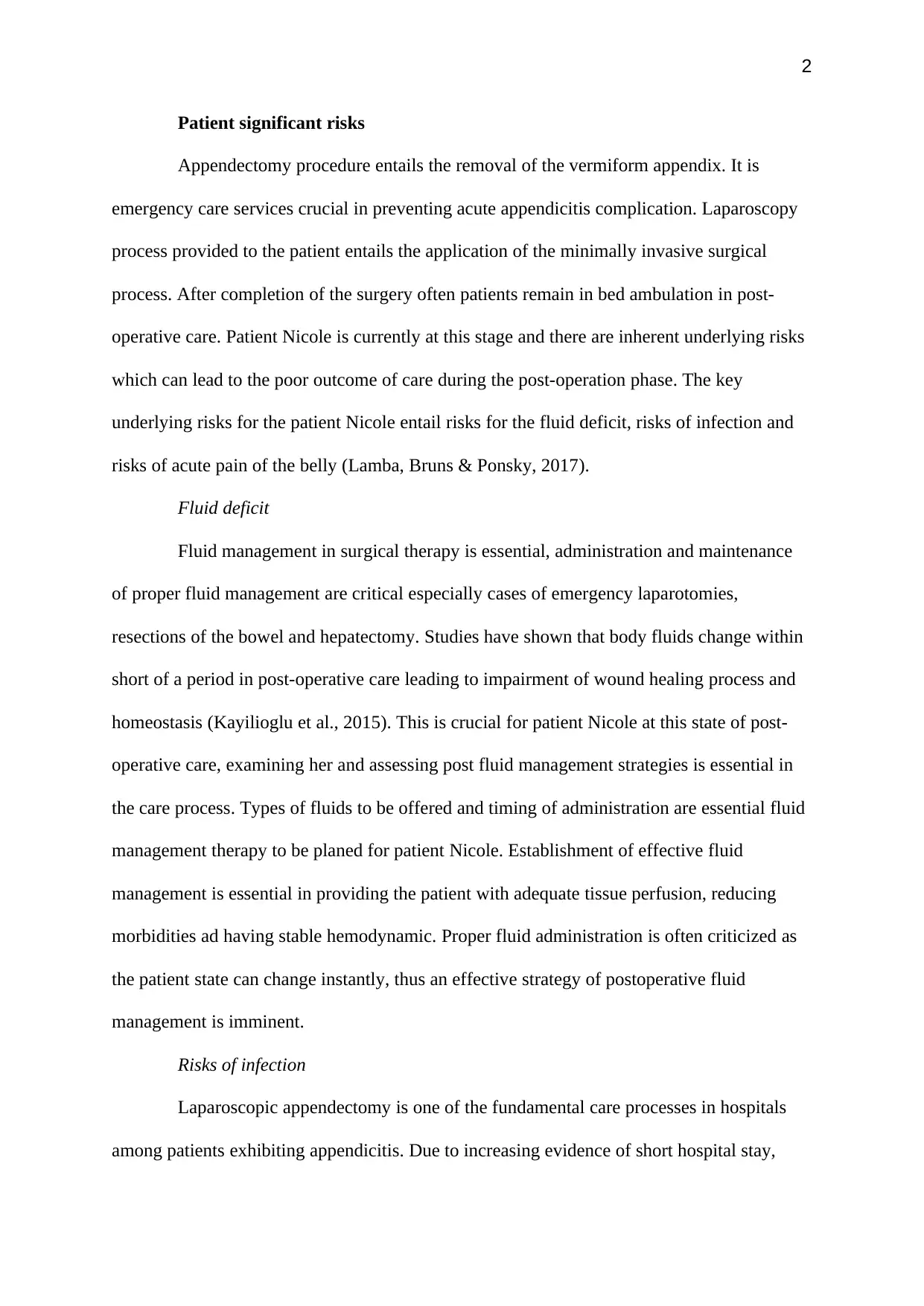
2
Patient significant risks
Appendectomy procedure entails the removal of the vermiform appendix. It is
emergency care services crucial in preventing acute appendicitis complication. Laparoscopy
process provided to the patient entails the application of the minimally invasive surgical
process. After completion of the surgery often patients remain in bed ambulation in post-
operative care. Patient Nicole is currently at this stage and there are inherent underlying risks
which can lead to the poor outcome of care during the post-operation phase. The key
underlying risks for the patient Nicole entail risks for the fluid deficit, risks of infection and
risks of acute pain of the belly (Lamba, Bruns & Ponsky, 2017).
Fluid deficit
Fluid management in surgical therapy is essential, administration and maintenance
of proper fluid management are critical especially cases of emergency laparotomies,
resections of the bowel and hepatectomy. Studies have shown that body fluids change within
short of a period in post-operative care leading to impairment of wound healing process and
homeostasis (Kayilioglu et al., 2015). This is crucial for patient Nicole at this state of post-
operative care, examining her and assessing post fluid management strategies is essential in
the care process. Types of fluids to be offered and timing of administration are essential fluid
management therapy to be planed for patient Nicole. Establishment of effective fluid
management is essential in providing the patient with adequate tissue perfusion, reducing
morbidities ad having stable hemodynamic. Proper fluid administration is often criticized as
the patient state can change instantly, thus an effective strategy of postoperative fluid
management is imminent.
Risks of infection
Laparoscopic appendectomy is one of the fundamental care processes in hospitals
among patients exhibiting appendicitis. Due to increasing evidence of short hospital stay,
Patient significant risks
Appendectomy procedure entails the removal of the vermiform appendix. It is
emergency care services crucial in preventing acute appendicitis complication. Laparoscopy
process provided to the patient entails the application of the minimally invasive surgical
process. After completion of the surgery often patients remain in bed ambulation in post-
operative care. Patient Nicole is currently at this stage and there are inherent underlying risks
which can lead to the poor outcome of care during the post-operation phase. The key
underlying risks for the patient Nicole entail risks for the fluid deficit, risks of infection and
risks of acute pain of the belly (Lamba, Bruns & Ponsky, 2017).
Fluid deficit
Fluid management in surgical therapy is essential, administration and maintenance
of proper fluid management are critical especially cases of emergency laparotomies,
resections of the bowel and hepatectomy. Studies have shown that body fluids change within
short of a period in post-operative care leading to impairment of wound healing process and
homeostasis (Kayilioglu et al., 2015). This is crucial for patient Nicole at this state of post-
operative care, examining her and assessing post fluid management strategies is essential in
the care process. Types of fluids to be offered and timing of administration are essential fluid
management therapy to be planed for patient Nicole. Establishment of effective fluid
management is essential in providing the patient with adequate tissue perfusion, reducing
morbidities ad having stable hemodynamic. Proper fluid administration is often criticized as
the patient state can change instantly, thus an effective strategy of postoperative fluid
management is imminent.
Risks of infection
Laparoscopic appendectomy is one of the fundamental care processes in hospitals
among patients exhibiting appendicitis. Due to increasing evidence of short hospital stay,
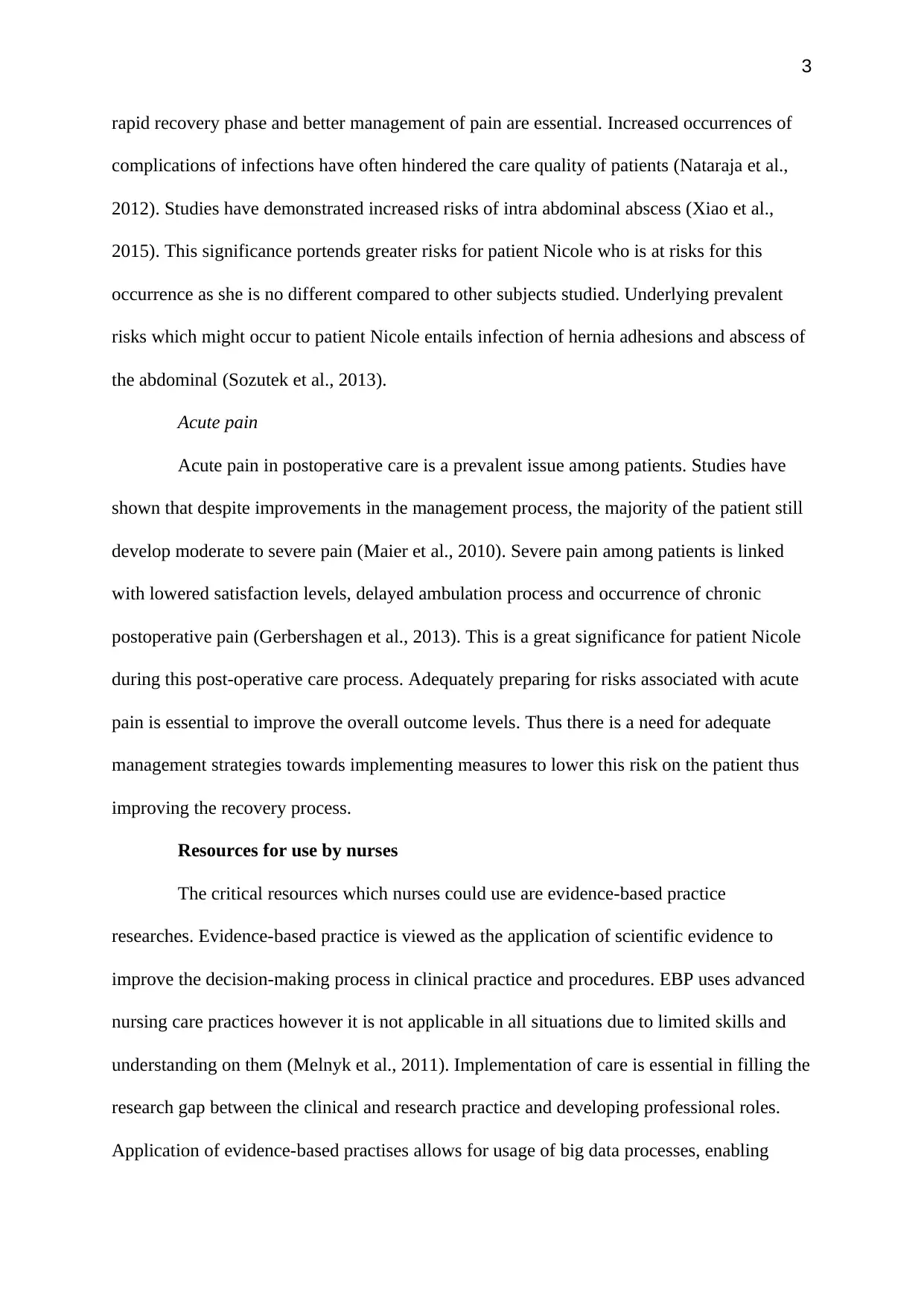
3
rapid recovery phase and better management of pain are essential. Increased occurrences of
complications of infections have often hindered the care quality of patients (Nataraja et al.,
2012). Studies have demonstrated increased risks of intra abdominal abscess (Xiao et al.,
2015). This significance portends greater risks for patient Nicole who is at risks for this
occurrence as she is no different compared to other subjects studied. Underlying prevalent
risks which might occur to patient Nicole entails infection of hernia adhesions and abscess of
the abdominal (Sozutek et al., 2013).
Acute pain
Acute pain in postoperative care is a prevalent issue among patients. Studies have
shown that despite improvements in the management process, the majority of the patient still
develop moderate to severe pain (Maier et al., 2010). Severe pain among patients is linked
with lowered satisfaction levels, delayed ambulation process and occurrence of chronic
postoperative pain (Gerbershagen et al., 2013). This is a great significance for patient Nicole
during this post-operative care process. Adequately preparing for risks associated with acute
pain is essential to improve the overall outcome levels. Thus there is a need for adequate
management strategies towards implementing measures to lower this risk on the patient thus
improving the recovery process.
Resources for use by nurses
The critical resources which nurses could use are evidence-based practice
researches. Evidence-based practice is viewed as the application of scientific evidence to
improve the decision-making process in clinical practice and procedures. EBP uses advanced
nursing care practices however it is not applicable in all situations due to limited skills and
understanding on them (Melnyk et al., 2011). Implementation of care is essential in filling the
research gap between the clinical and research practice and developing professional roles.
Application of evidence-based practises allows for usage of big data processes, enabling
rapid recovery phase and better management of pain are essential. Increased occurrences of
complications of infections have often hindered the care quality of patients (Nataraja et al.,
2012). Studies have demonstrated increased risks of intra abdominal abscess (Xiao et al.,
2015). This significance portends greater risks for patient Nicole who is at risks for this
occurrence as she is no different compared to other subjects studied. Underlying prevalent
risks which might occur to patient Nicole entails infection of hernia adhesions and abscess of
the abdominal (Sozutek et al., 2013).
Acute pain
Acute pain in postoperative care is a prevalent issue among patients. Studies have
shown that despite improvements in the management process, the majority of the patient still
develop moderate to severe pain (Maier et al., 2010). Severe pain among patients is linked
with lowered satisfaction levels, delayed ambulation process and occurrence of chronic
postoperative pain (Gerbershagen et al., 2013). This is a great significance for patient Nicole
during this post-operative care process. Adequately preparing for risks associated with acute
pain is essential to improve the overall outcome levels. Thus there is a need for adequate
management strategies towards implementing measures to lower this risk on the patient thus
improving the recovery process.
Resources for use by nurses
The critical resources which nurses could use are evidence-based practice
researches. Evidence-based practice is viewed as the application of scientific evidence to
improve the decision-making process in clinical practice and procedures. EBP uses advanced
nursing care practices however it is not applicable in all situations due to limited skills and
understanding on them (Melnyk et al., 2011). Implementation of care is essential in filling the
research gap between the clinical and research practice and developing professional roles.
Application of evidence-based practises allows for usage of big data processes, enabling
⊘ This is a preview!⊘
Do you want full access?
Subscribe today to unlock all pages.

Trusted by 1+ million students worldwide
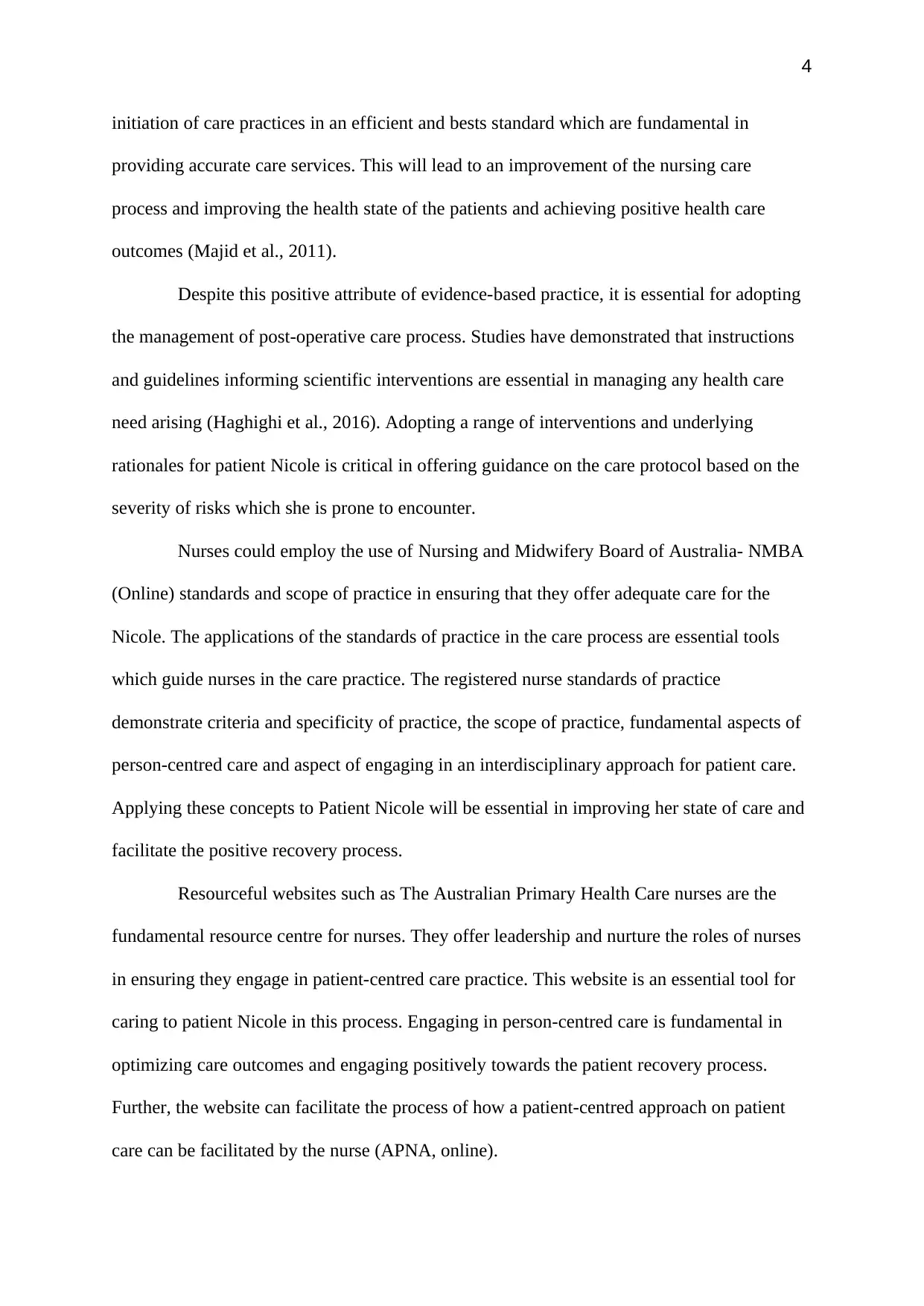
4
initiation of care practices in an efficient and bests standard which are fundamental in
providing accurate care services. This will lead to an improvement of the nursing care
process and improving the health state of the patients and achieving positive health care
outcomes (Majid et al., 2011).
Despite this positive attribute of evidence-based practice, it is essential for adopting
the management of post-operative care process. Studies have demonstrated that instructions
and guidelines informing scientific interventions are essential in managing any health care
need arising (Haghighi et al., 2016). Adopting a range of interventions and underlying
rationales for patient Nicole is critical in offering guidance on the care protocol based on the
severity of risks which she is prone to encounter.
Nurses could employ the use of Nursing and Midwifery Board of Australia- NMBA
(Online) standards and scope of practice in ensuring that they offer adequate care for the
Nicole. The applications of the standards of practice in the care process are essential tools
which guide nurses in the care practice. The registered nurse standards of practice
demonstrate criteria and specificity of practice, the scope of practice, fundamental aspects of
person-centred care and aspect of engaging in an interdisciplinary approach for patient care.
Applying these concepts to Patient Nicole will be essential in improving her state of care and
facilitate the positive recovery process.
Resourceful websites such as The Australian Primary Health Care nurses are the
fundamental resource centre for nurses. They offer leadership and nurture the roles of nurses
in ensuring they engage in patient-centred care practice. This website is an essential tool for
caring to patient Nicole in this process. Engaging in person-centred care is fundamental in
optimizing care outcomes and engaging positively towards the patient recovery process.
Further, the website can facilitate the process of how a patient-centred approach on patient
care can be facilitated by the nurse (APNA, online).
initiation of care practices in an efficient and bests standard which are fundamental in
providing accurate care services. This will lead to an improvement of the nursing care
process and improving the health state of the patients and achieving positive health care
outcomes (Majid et al., 2011).
Despite this positive attribute of evidence-based practice, it is essential for adopting
the management of post-operative care process. Studies have demonstrated that instructions
and guidelines informing scientific interventions are essential in managing any health care
need arising (Haghighi et al., 2016). Adopting a range of interventions and underlying
rationales for patient Nicole is critical in offering guidance on the care protocol based on the
severity of risks which she is prone to encounter.
Nurses could employ the use of Nursing and Midwifery Board of Australia- NMBA
(Online) standards and scope of practice in ensuring that they offer adequate care for the
Nicole. The applications of the standards of practice in the care process are essential tools
which guide nurses in the care practice. The registered nurse standards of practice
demonstrate criteria and specificity of practice, the scope of practice, fundamental aspects of
person-centred care and aspect of engaging in an interdisciplinary approach for patient care.
Applying these concepts to Patient Nicole will be essential in improving her state of care and
facilitate the positive recovery process.
Resourceful websites such as The Australian Primary Health Care nurses are the
fundamental resource centre for nurses. They offer leadership and nurture the roles of nurses
in ensuring they engage in patient-centred care practice. This website is an essential tool for
caring to patient Nicole in this process. Engaging in person-centred care is fundamental in
optimizing care outcomes and engaging positively towards the patient recovery process.
Further, the website can facilitate the process of how a patient-centred approach on patient
care can be facilitated by the nurse (APNA, online).
Paraphrase This Document
Need a fresh take? Get an instant paraphrase of this document with our AI Paraphraser
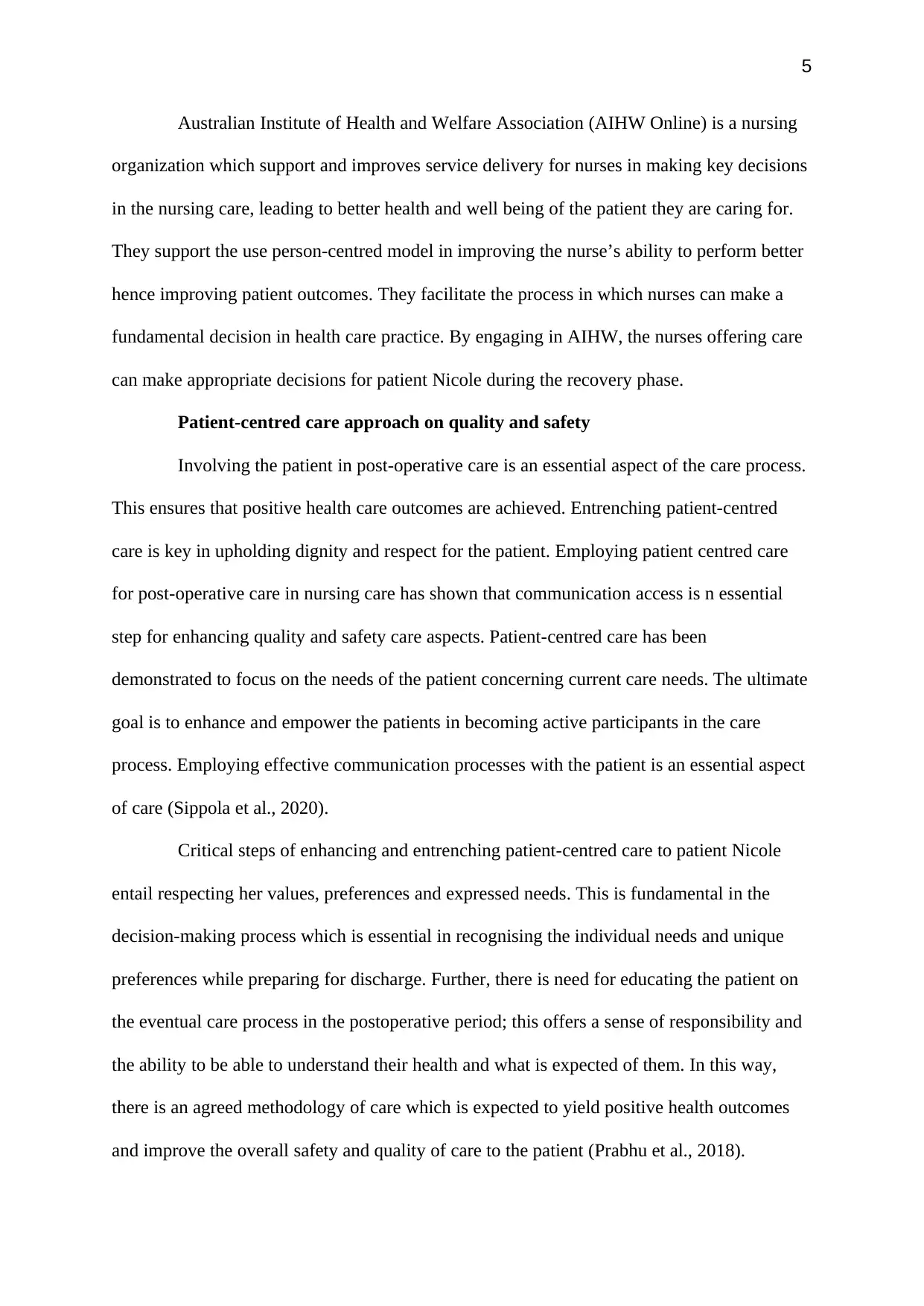
5
Australian Institute of Health and Welfare Association (AIHW Online) is a nursing
organization which support and improves service delivery for nurses in making key decisions
in the nursing care, leading to better health and well being of the patient they are caring for.
They support the use person-centred model in improving the nurse’s ability to perform better
hence improving patient outcomes. They facilitate the process in which nurses can make a
fundamental decision in health care practice. By engaging in AIHW, the nurses offering care
can make appropriate decisions for patient Nicole during the recovery phase.
Patient-centred care approach on quality and safety
Involving the patient in post-operative care is an essential aspect of the care process.
This ensures that positive health care outcomes are achieved. Entrenching patient-centred
care is key in upholding dignity and respect for the patient. Employing patient centred care
for post-operative care in nursing care has shown that communication access is n essential
step for enhancing quality and safety care aspects. Patient-centred care has been
demonstrated to focus on the needs of the patient concerning current care needs. The ultimate
goal is to enhance and empower the patients in becoming active participants in the care
process. Employing effective communication processes with the patient is an essential aspect
of care (Sippola et al., 2020).
Critical steps of enhancing and entrenching patient-centred care to patient Nicole
entail respecting her values, preferences and expressed needs. This is fundamental in the
decision-making process which is essential in recognising the individual needs and unique
preferences while preparing for discharge. Further, there is need for educating the patient on
the eventual care process in the postoperative period; this offers a sense of responsibility and
the ability to be able to understand their health and what is expected of them. In this way,
there is an agreed methodology of care which is expected to yield positive health outcomes
and improve the overall safety and quality of care to the patient (Prabhu et al., 2018).
Australian Institute of Health and Welfare Association (AIHW Online) is a nursing
organization which support and improves service delivery for nurses in making key decisions
in the nursing care, leading to better health and well being of the patient they are caring for.
They support the use person-centred model in improving the nurse’s ability to perform better
hence improving patient outcomes. They facilitate the process in which nurses can make a
fundamental decision in health care practice. By engaging in AIHW, the nurses offering care
can make appropriate decisions for patient Nicole during the recovery phase.
Patient-centred care approach on quality and safety
Involving the patient in post-operative care is an essential aspect of the care process.
This ensures that positive health care outcomes are achieved. Entrenching patient-centred
care is key in upholding dignity and respect for the patient. Employing patient centred care
for post-operative care in nursing care has shown that communication access is n essential
step for enhancing quality and safety care aspects. Patient-centred care has been
demonstrated to focus on the needs of the patient concerning current care needs. The ultimate
goal is to enhance and empower the patients in becoming active participants in the care
process. Employing effective communication processes with the patient is an essential aspect
of care (Sippola et al., 2020).
Critical steps of enhancing and entrenching patient-centred care to patient Nicole
entail respecting her values, preferences and expressed needs. This is fundamental in the
decision-making process which is essential in recognising the individual needs and unique
preferences while preparing for discharge. Further, there is need for educating the patient on
the eventual care process in the postoperative period; this offers a sense of responsibility and
the ability to be able to understand their health and what is expected of them. In this way,
there is an agreed methodology of care which is expected to yield positive health outcomes
and improve the overall safety and quality of care to the patient (Prabhu et al., 2018).
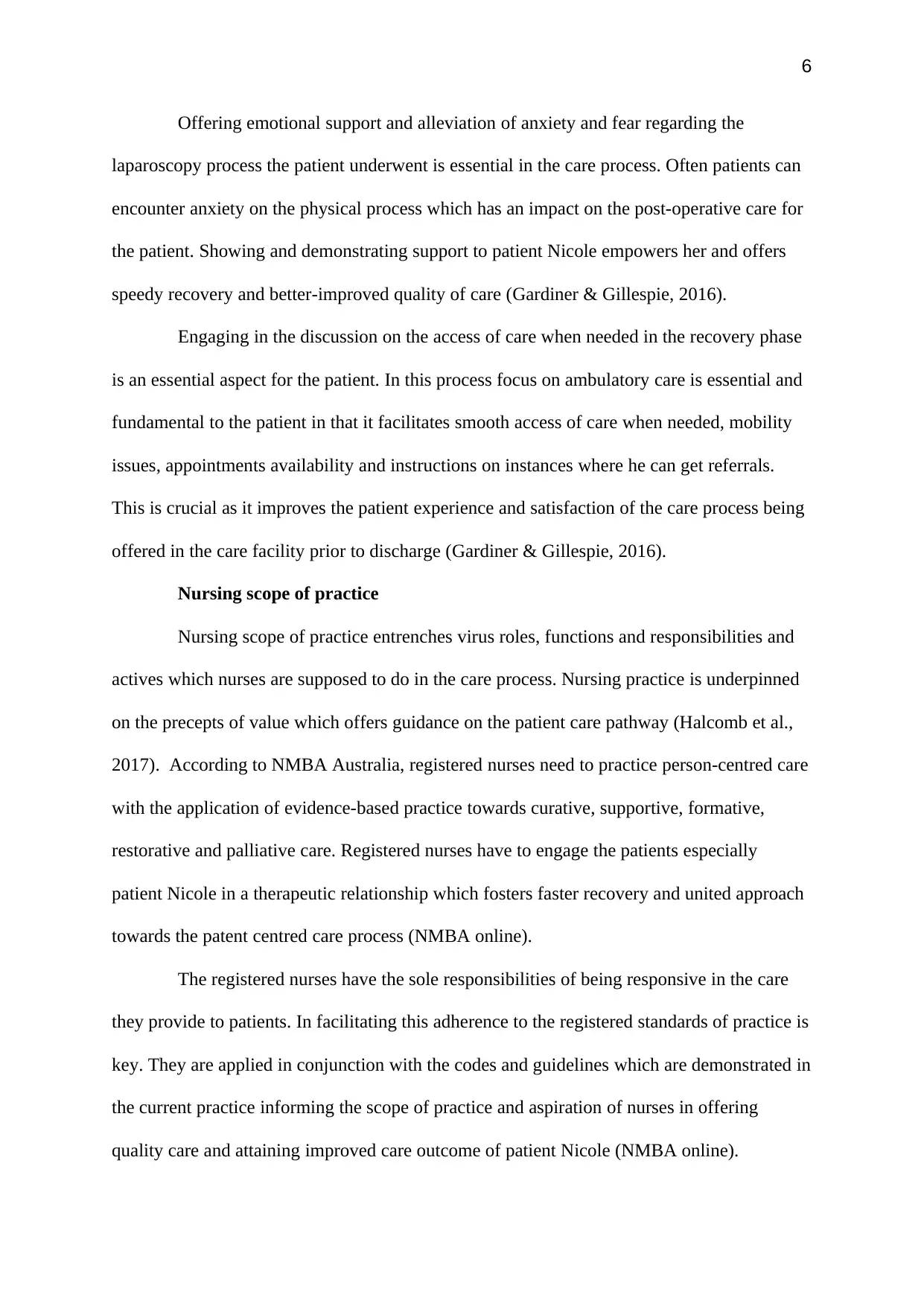
6
Offering emotional support and alleviation of anxiety and fear regarding the
laparoscopy process the patient underwent is essential in the care process. Often patients can
encounter anxiety on the physical process which has an impact on the post-operative care for
the patient. Showing and demonstrating support to patient Nicole empowers her and offers
speedy recovery and better-improved quality of care (Gardiner & Gillespie, 2016).
Engaging in the discussion on the access of care when needed in the recovery phase
is an essential aspect for the patient. In this process focus on ambulatory care is essential and
fundamental to the patient in that it facilitates smooth access of care when needed, mobility
issues, appointments availability and instructions on instances where he can get referrals.
This is crucial as it improves the patient experience and satisfaction of the care process being
offered in the care facility prior to discharge (Gardiner & Gillespie, 2016).
Nursing scope of practice
Nursing scope of practice entrenches virus roles, functions and responsibilities and
actives which nurses are supposed to do in the care process. Nursing practice is underpinned
on the precepts of value which offers guidance on the patient care pathway (Halcomb et al.,
2017). According to NMBA Australia, registered nurses need to practice person-centred care
with the application of evidence-based practice towards curative, supportive, formative,
restorative and palliative care. Registered nurses have to engage the patients especially
patient Nicole in a therapeutic relationship which fosters faster recovery and united approach
towards the patent centred care process (NMBA online).
The registered nurses have the sole responsibilities of being responsive in the care
they provide to patients. In facilitating this adherence to the registered standards of practice is
key. They are applied in conjunction with the codes and guidelines which are demonstrated in
the current practice informing the scope of practice and aspiration of nurses in offering
quality care and attaining improved care outcome of patient Nicole (NMBA online).
Offering emotional support and alleviation of anxiety and fear regarding the
laparoscopy process the patient underwent is essential in the care process. Often patients can
encounter anxiety on the physical process which has an impact on the post-operative care for
the patient. Showing and demonstrating support to patient Nicole empowers her and offers
speedy recovery and better-improved quality of care (Gardiner & Gillespie, 2016).
Engaging in the discussion on the access of care when needed in the recovery phase
is an essential aspect for the patient. In this process focus on ambulatory care is essential and
fundamental to the patient in that it facilitates smooth access of care when needed, mobility
issues, appointments availability and instructions on instances where he can get referrals.
This is crucial as it improves the patient experience and satisfaction of the care process being
offered in the care facility prior to discharge (Gardiner & Gillespie, 2016).
Nursing scope of practice
Nursing scope of practice entrenches virus roles, functions and responsibilities and
actives which nurses are supposed to do in the care process. Nursing practice is underpinned
on the precepts of value which offers guidance on the patient care pathway (Halcomb et al.,
2017). According to NMBA Australia, registered nurses need to practice person-centred care
with the application of evidence-based practice towards curative, supportive, formative,
restorative and palliative care. Registered nurses have to engage the patients especially
patient Nicole in a therapeutic relationship which fosters faster recovery and united approach
towards the patent centred care process (NMBA online).
The registered nurses have the sole responsibilities of being responsive in the care
they provide to patients. In facilitating this adherence to the registered standards of practice is
key. They are applied in conjunction with the codes and guidelines which are demonstrated in
the current practice informing the scope of practice and aspiration of nurses in offering
quality care and attaining improved care outcome of patient Nicole (NMBA online).
⊘ This is a preview!⊘
Do you want full access?
Subscribe today to unlock all pages.

Trusted by 1+ million students worldwide
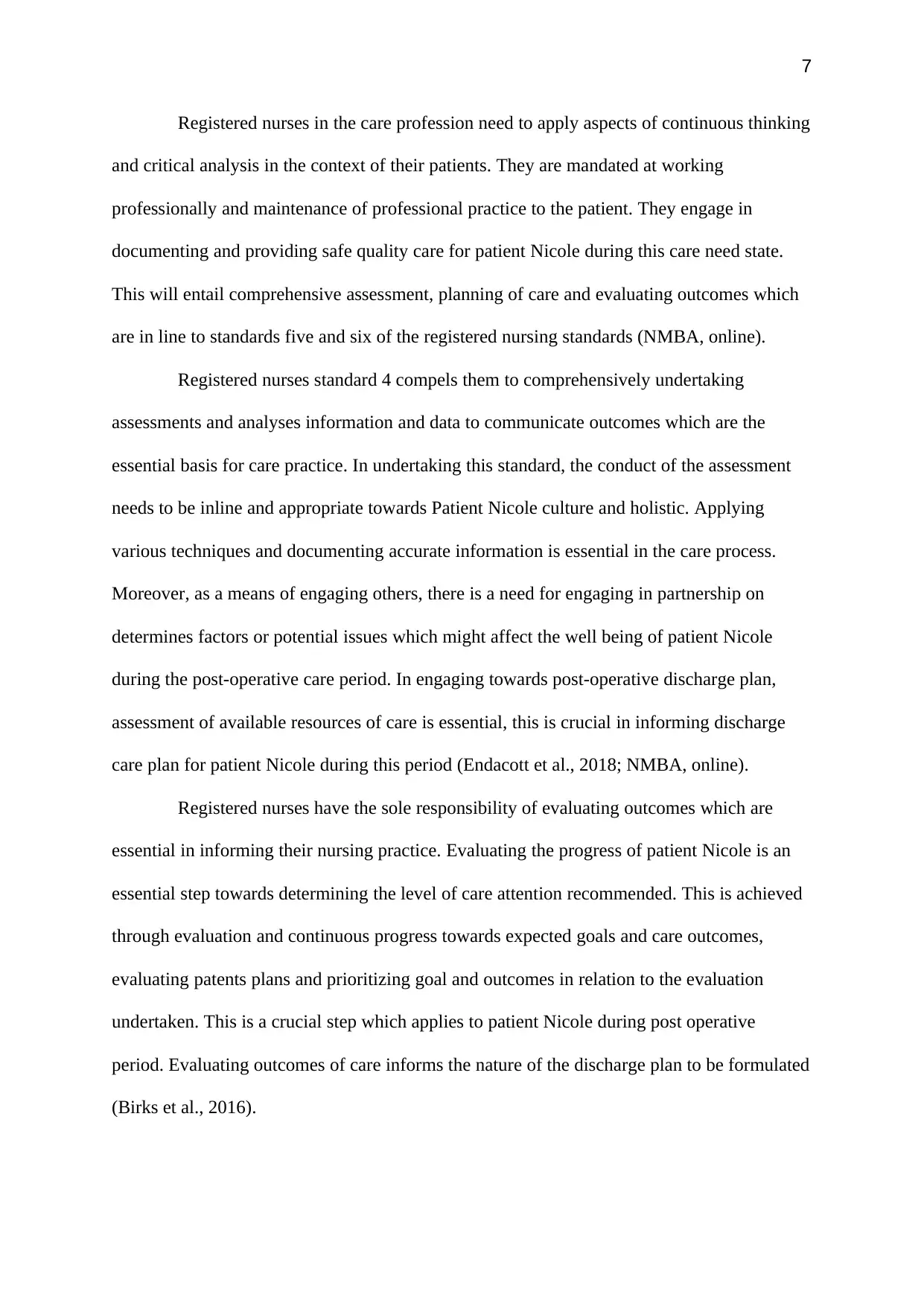
7
Registered nurses in the care profession need to apply aspects of continuous thinking
and critical analysis in the context of their patients. They are mandated at working
professionally and maintenance of professional practice to the patient. They engage in
documenting and providing safe quality care for patient Nicole during this care need state.
This will entail comprehensive assessment, planning of care and evaluating outcomes which
are in line to standards five and six of the registered nursing standards (NMBA, online).
Registered nurses standard 4 compels them to comprehensively undertaking
assessments and analyses information and data to communicate outcomes which are the
essential basis for care practice. In undertaking this standard, the conduct of the assessment
needs to be inline and appropriate towards Patient Nicole culture and holistic. Applying
various techniques and documenting accurate information is essential in the care process.
Moreover, as a means of engaging others, there is a need for engaging in partnership on
determines factors or potential issues which might affect the well being of patient Nicole
during the post-operative care period. In engaging towards post-operative discharge plan,
assessment of available resources of care is essential, this is crucial in informing discharge
care plan for patient Nicole during this period (Endacott et al., 2018; NMBA, online).
Registered nurses have the sole responsibility of evaluating outcomes which are
essential in informing their nursing practice. Evaluating the progress of patient Nicole is an
essential step towards determining the level of care attention recommended. This is achieved
through evaluation and continuous progress towards expected goals and care outcomes,
evaluating patents plans and prioritizing goal and outcomes in relation to the evaluation
undertaken. This is a crucial step which applies to patient Nicole during post operative
period. Evaluating outcomes of care informs the nature of the discharge plan to be formulated
(Birks et al., 2016).
Registered nurses in the care profession need to apply aspects of continuous thinking
and critical analysis in the context of their patients. They are mandated at working
professionally and maintenance of professional practice to the patient. They engage in
documenting and providing safe quality care for patient Nicole during this care need state.
This will entail comprehensive assessment, planning of care and evaluating outcomes which
are in line to standards five and six of the registered nursing standards (NMBA, online).
Registered nurses standard 4 compels them to comprehensively undertaking
assessments and analyses information and data to communicate outcomes which are the
essential basis for care practice. In undertaking this standard, the conduct of the assessment
needs to be inline and appropriate towards Patient Nicole culture and holistic. Applying
various techniques and documenting accurate information is essential in the care process.
Moreover, as a means of engaging others, there is a need for engaging in partnership on
determines factors or potential issues which might affect the well being of patient Nicole
during the post-operative care period. In engaging towards post-operative discharge plan,
assessment of available resources of care is essential, this is crucial in informing discharge
care plan for patient Nicole during this period (Endacott et al., 2018; NMBA, online).
Registered nurses have the sole responsibility of evaluating outcomes which are
essential in informing their nursing practice. Evaluating the progress of patient Nicole is an
essential step towards determining the level of care attention recommended. This is achieved
through evaluation and continuous progress towards expected goals and care outcomes,
evaluating patents plans and prioritizing goal and outcomes in relation to the evaluation
undertaken. This is a crucial step which applies to patient Nicole during post operative
period. Evaluating outcomes of care informs the nature of the discharge plan to be formulated
(Birks et al., 2016).
Paraphrase This Document
Need a fresh take? Get an instant paraphrase of this document with our AI Paraphraser
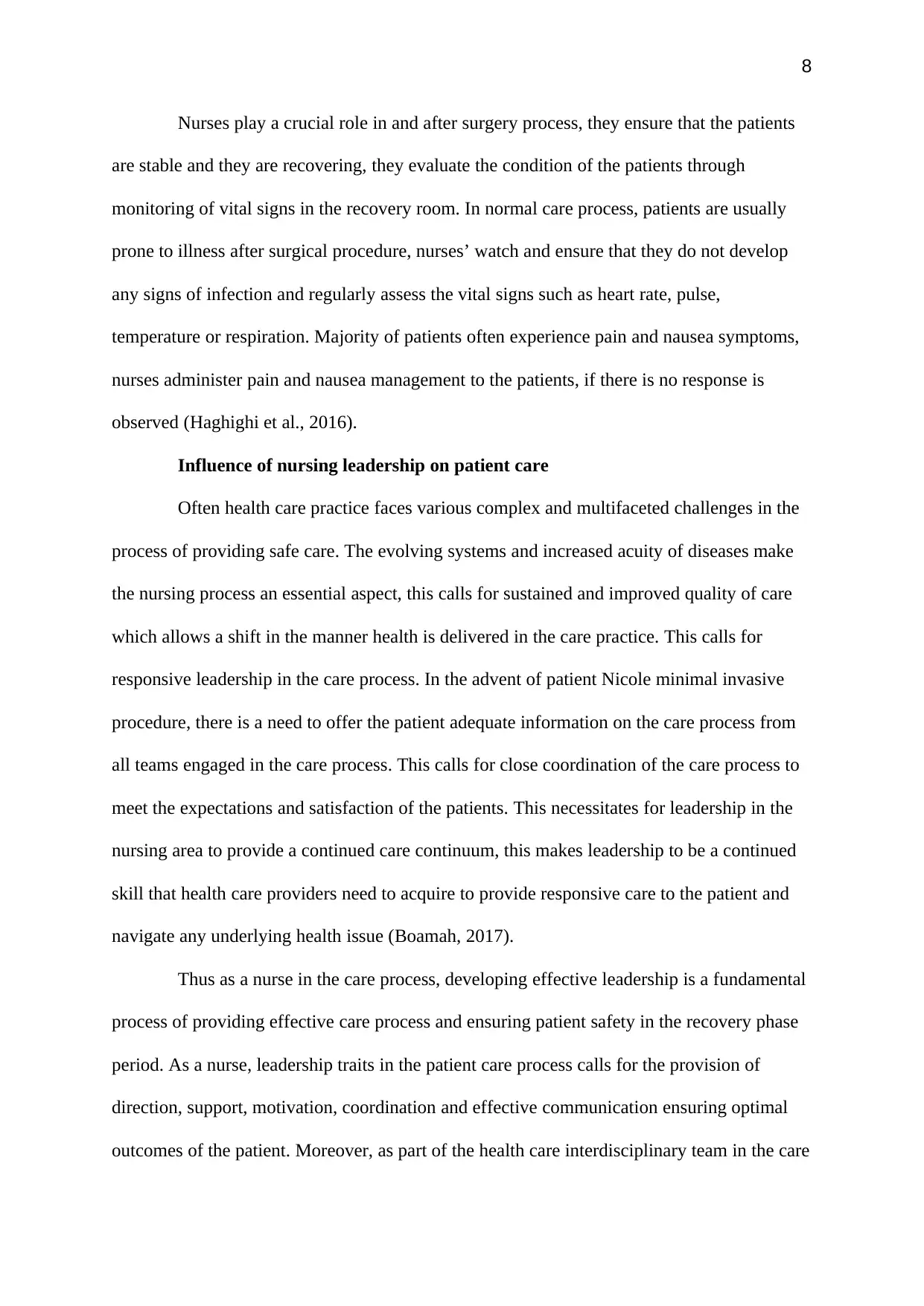
8
Nurses play a crucial role in and after surgery process, they ensure that the patients
are stable and they are recovering, they evaluate the condition of the patients through
monitoring of vital signs in the recovery room. In normal care process, patients are usually
prone to illness after surgical procedure, nurses’ watch and ensure that they do not develop
any signs of infection and regularly assess the vital signs such as heart rate, pulse,
temperature or respiration. Majority of patients often experience pain and nausea symptoms,
nurses administer pain and nausea management to the patients, if there is no response is
observed (Haghighi et al., 2016).
Influence of nursing leadership on patient care
Often health care practice faces various complex and multifaceted challenges in the
process of providing safe care. The evolving systems and increased acuity of diseases make
the nursing process an essential aspect, this calls for sustained and improved quality of care
which allows a shift in the manner health is delivered in the care practice. This calls for
responsive leadership in the care process. In the advent of patient Nicole minimal invasive
procedure, there is a need to offer the patient adequate information on the care process from
all teams engaged in the care process. This calls for close coordination of the care process to
meet the expectations and satisfaction of the patients. This necessitates for leadership in the
nursing area to provide a continued care continuum, this makes leadership to be a continued
skill that health care providers need to acquire to provide responsive care to the patient and
navigate any underlying health issue (Boamah, 2017).
Thus as a nurse in the care process, developing effective leadership is a fundamental
process of providing effective care process and ensuring patient safety in the recovery phase
period. As a nurse, leadership traits in the patient care process calls for the provision of
direction, support, motivation, coordination and effective communication ensuring optimal
outcomes of the patient. Moreover, as part of the health care interdisciplinary team in the care
Nurses play a crucial role in and after surgery process, they ensure that the patients
are stable and they are recovering, they evaluate the condition of the patients through
monitoring of vital signs in the recovery room. In normal care process, patients are usually
prone to illness after surgical procedure, nurses’ watch and ensure that they do not develop
any signs of infection and regularly assess the vital signs such as heart rate, pulse,
temperature or respiration. Majority of patients often experience pain and nausea symptoms,
nurses administer pain and nausea management to the patients, if there is no response is
observed (Haghighi et al., 2016).
Influence of nursing leadership on patient care
Often health care practice faces various complex and multifaceted challenges in the
process of providing safe care. The evolving systems and increased acuity of diseases make
the nursing process an essential aspect, this calls for sustained and improved quality of care
which allows a shift in the manner health is delivered in the care practice. This calls for
responsive leadership in the care process. In the advent of patient Nicole minimal invasive
procedure, there is a need to offer the patient adequate information on the care process from
all teams engaged in the care process. This calls for close coordination of the care process to
meet the expectations and satisfaction of the patients. This necessitates for leadership in the
nursing area to provide a continued care continuum, this makes leadership to be a continued
skill that health care providers need to acquire to provide responsive care to the patient and
navigate any underlying health issue (Boamah, 2017).
Thus as a nurse in the care process, developing effective leadership is a fundamental
process of providing effective care process and ensuring patient safety in the recovery phase
period. As a nurse, leadership traits in the patient care process calls for the provision of
direction, support, motivation, coordination and effective communication ensuring optimal
outcomes of the patient. Moreover, as part of the health care interdisciplinary team in the care
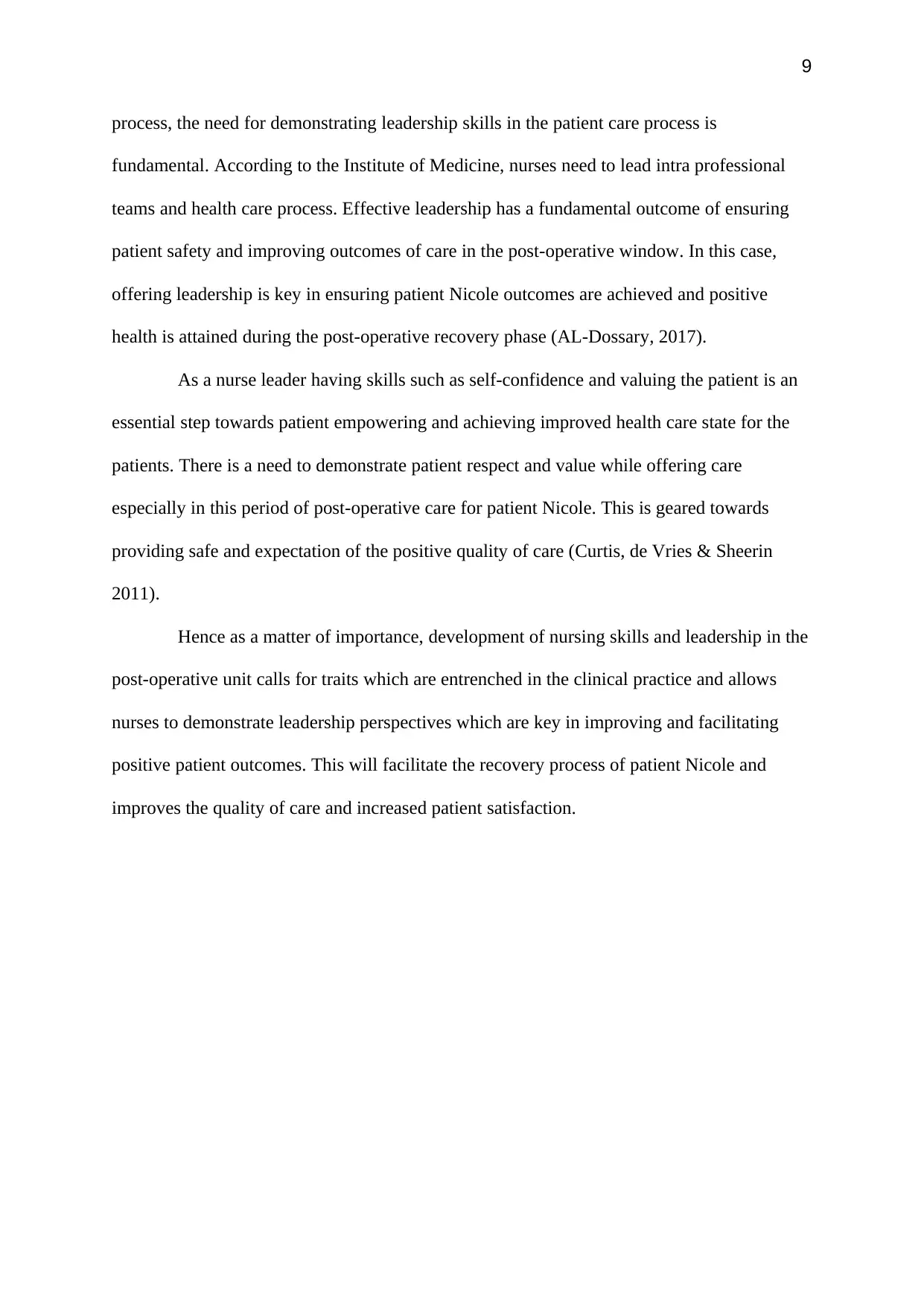
9
process, the need for demonstrating leadership skills in the patient care process is
fundamental. According to the Institute of Medicine, nurses need to lead intra professional
teams and health care process. Effective leadership has a fundamental outcome of ensuring
patient safety and improving outcomes of care in the post-operative window. In this case,
offering leadership is key in ensuring patient Nicole outcomes are achieved and positive
health is attained during the post-operative recovery phase (AL-Dossary, 2017).
As a nurse leader having skills such as self-confidence and valuing the patient is an
essential step towards patient empowering and achieving improved health care state for the
patients. There is a need to demonstrate patient respect and value while offering care
especially in this period of post-operative care for patient Nicole. This is geared towards
providing safe and expectation of the positive quality of care (Curtis, de Vries & Sheerin
2011).
Hence as a matter of importance, development of nursing skills and leadership in the
post-operative unit calls for traits which are entrenched in the clinical practice and allows
nurses to demonstrate leadership perspectives which are key in improving and facilitating
positive patient outcomes. This will facilitate the recovery process of patient Nicole and
improves the quality of care and increased patient satisfaction.
process, the need for demonstrating leadership skills in the patient care process is
fundamental. According to the Institute of Medicine, nurses need to lead intra professional
teams and health care process. Effective leadership has a fundamental outcome of ensuring
patient safety and improving outcomes of care in the post-operative window. In this case,
offering leadership is key in ensuring patient Nicole outcomes are achieved and positive
health is attained during the post-operative recovery phase (AL-Dossary, 2017).
As a nurse leader having skills such as self-confidence and valuing the patient is an
essential step towards patient empowering and achieving improved health care state for the
patients. There is a need to demonstrate patient respect and value while offering care
especially in this period of post-operative care for patient Nicole. This is geared towards
providing safe and expectation of the positive quality of care (Curtis, de Vries & Sheerin
2011).
Hence as a matter of importance, development of nursing skills and leadership in the
post-operative unit calls for traits which are entrenched in the clinical practice and allows
nurses to demonstrate leadership perspectives which are key in improving and facilitating
positive patient outcomes. This will facilitate the recovery process of patient Nicole and
improves the quality of care and increased patient satisfaction.
⊘ This is a preview!⊘
Do you want full access?
Subscribe today to unlock all pages.

Trusted by 1+ million students worldwide
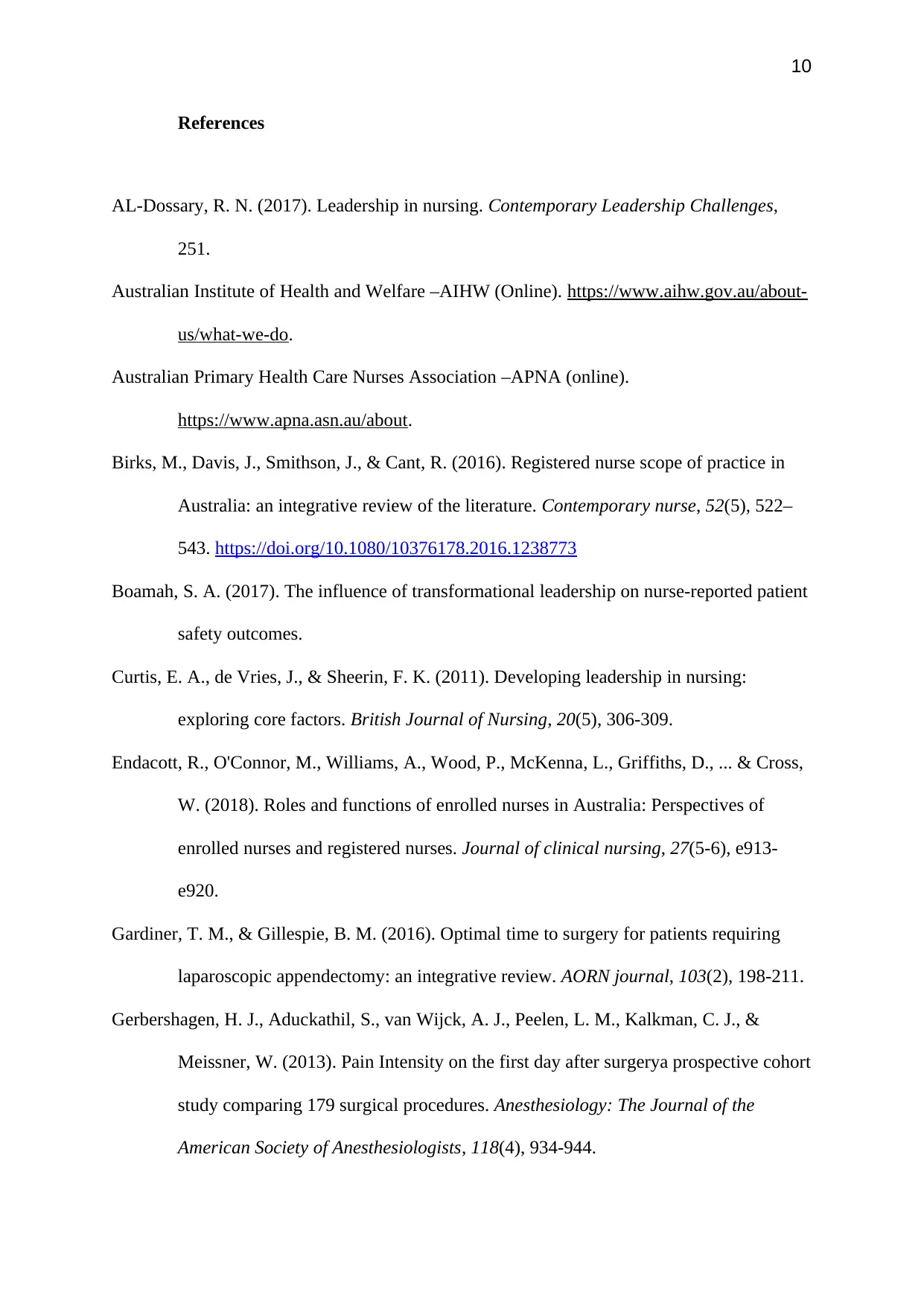
10
References
AL-Dossary, R. N. (2017). Leadership in nursing. Contemporary Leadership Challenges,
251.
Australian Institute of Health and Welfare –AIHW (Online). https://www.aihw.gov.au/about-
us/what-we-do.
Australian Primary Health Care Nurses Association –APNA (online).
https://www.apna.asn.au/about.
Birks, M., Davis, J., Smithson, J., & Cant, R. (2016). Registered nurse scope of practice in
Australia: an integrative review of the literature. Contemporary nurse, 52(5), 522–
543. https://doi.org/10.1080/10376178.2016.1238773
Boamah, S. A. (2017). The influence of transformational leadership on nurse-reported patient
safety outcomes.
Curtis, E. A., de Vries, J., & Sheerin, F. K. (2011). Developing leadership in nursing:
exploring core factors. British Journal of Nursing, 20(5), 306-309.
Endacott, R., O'Connor, M., Williams, A., Wood, P., McKenna, L., Griffiths, D., ... & Cross,
W. (2018). Roles and functions of enrolled nurses in Australia: Perspectives of
enrolled nurses and registered nurses. Journal of clinical nursing, 27(5-6), e913-
e920.
Gardiner, T. M., & Gillespie, B. M. (2016). Optimal time to surgery for patients requiring
laparoscopic appendectomy: an integrative review. AORN journal, 103(2), 198-211.
Gerbershagen, H. J., Aduckathil, S., van Wijck, A. J., Peelen, L. M., Kalkman, C. J., &
Meissner, W. (2013). Pain Intensity on the first day after surgerya prospective cohort
study comparing 179 surgical procedures. Anesthesiology: The Journal of the
American Society of Anesthesiologists, 118(4), 934-944.
References
AL-Dossary, R. N. (2017). Leadership in nursing. Contemporary Leadership Challenges,
251.
Australian Institute of Health and Welfare –AIHW (Online). https://www.aihw.gov.au/about-
us/what-we-do.
Australian Primary Health Care Nurses Association –APNA (online).
https://www.apna.asn.au/about.
Birks, M., Davis, J., Smithson, J., & Cant, R. (2016). Registered nurse scope of practice in
Australia: an integrative review of the literature. Contemporary nurse, 52(5), 522–
543. https://doi.org/10.1080/10376178.2016.1238773
Boamah, S. A. (2017). The influence of transformational leadership on nurse-reported patient
safety outcomes.
Curtis, E. A., de Vries, J., & Sheerin, F. K. (2011). Developing leadership in nursing:
exploring core factors. British Journal of Nursing, 20(5), 306-309.
Endacott, R., O'Connor, M., Williams, A., Wood, P., McKenna, L., Griffiths, D., ... & Cross,
W. (2018). Roles and functions of enrolled nurses in Australia: Perspectives of
enrolled nurses and registered nurses. Journal of clinical nursing, 27(5-6), e913-
e920.
Gardiner, T. M., & Gillespie, B. M. (2016). Optimal time to surgery for patients requiring
laparoscopic appendectomy: an integrative review. AORN journal, 103(2), 198-211.
Gerbershagen, H. J., Aduckathil, S., van Wijck, A. J., Peelen, L. M., Kalkman, C. J., &
Meissner, W. (2013). Pain Intensity on the first day after surgerya prospective cohort
study comparing 179 surgical procedures. Anesthesiology: The Journal of the
American Society of Anesthesiologists, 118(4), 934-944.
Paraphrase This Document
Need a fresh take? Get an instant paraphrase of this document with our AI Paraphraser
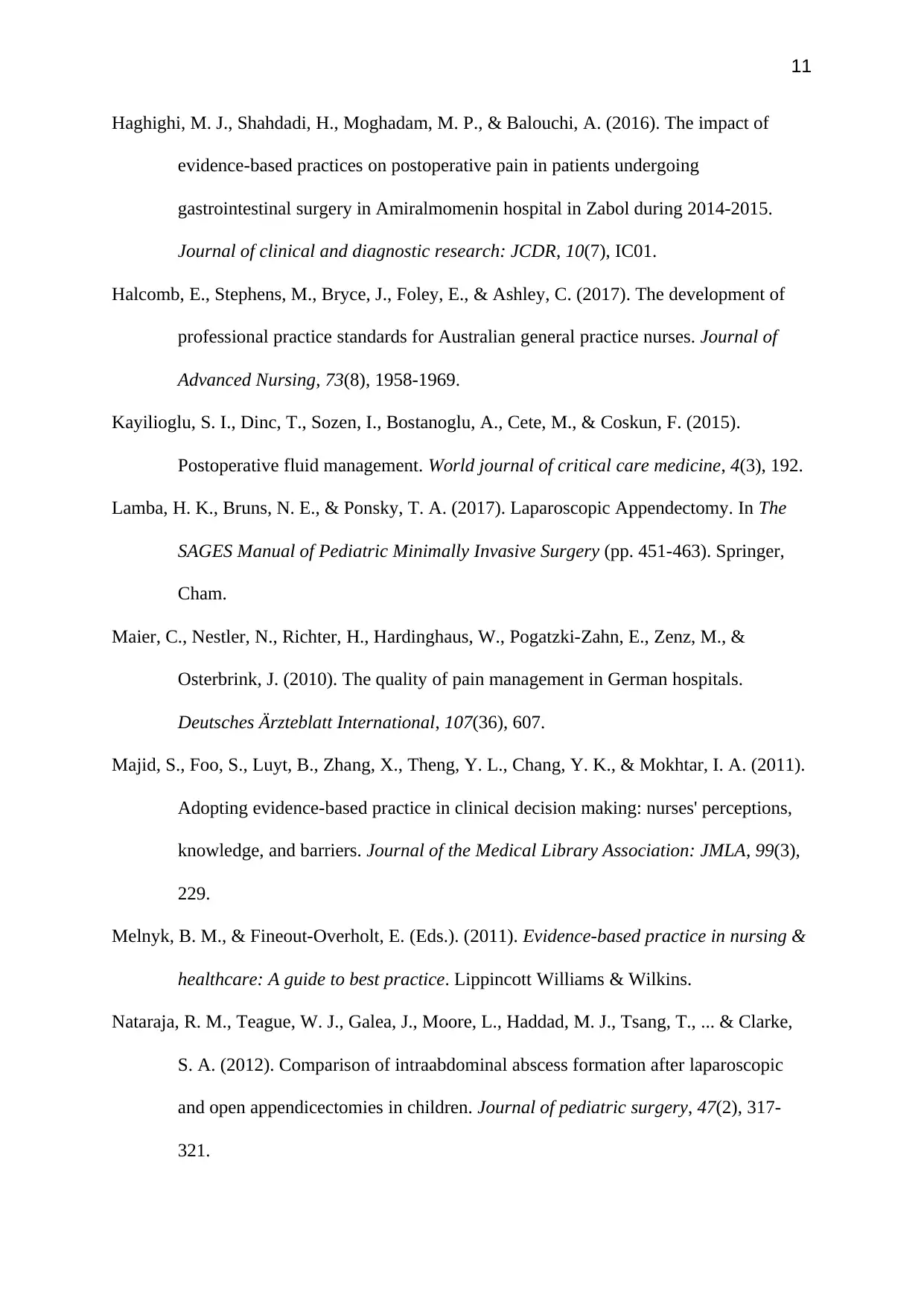
11
Haghighi, M. J., Shahdadi, H., Moghadam, M. P., & Balouchi, A. (2016). The impact of
evidence-based practices on postoperative pain in patients undergoing
gastrointestinal surgery in Amiralmomenin hospital in Zabol during 2014-2015.
Journal of clinical and diagnostic research: JCDR, 10(7), IC01.
Halcomb, E., Stephens, M., Bryce, J., Foley, E., & Ashley, C. (2017). The development of
professional practice standards for Australian general practice nurses. Journal of
Advanced Nursing, 73(8), 1958-1969.
Kayilioglu, S. I., Dinc, T., Sozen, I., Bostanoglu, A., Cete, M., & Coskun, F. (2015).
Postoperative fluid management. World journal of critical care medicine, 4(3), 192.
Lamba, H. K., Bruns, N. E., & Ponsky, T. A. (2017). Laparoscopic Appendectomy. In The
SAGES Manual of Pediatric Minimally Invasive Surgery (pp. 451-463). Springer,
Cham.
Maier, C., Nestler, N., Richter, H., Hardinghaus, W., Pogatzki-Zahn, E., Zenz, M., &
Osterbrink, J. (2010). The quality of pain management in German hospitals.
Deutsches Ärzteblatt International, 107(36), 607.
Majid, S., Foo, S., Luyt, B., Zhang, X., Theng, Y. L., Chang, Y. K., & Mokhtar, I. A. (2011).
Adopting evidence-based practice in clinical decision making: nurses' perceptions,
knowledge, and barriers. Journal of the Medical Library Association: JMLA, 99(3),
229.
Melnyk, B. M., & Fineout-Overholt, E. (Eds.). (2011). Evidence-based practice in nursing &
healthcare: A guide to best practice. Lippincott Williams & Wilkins.
Nataraja, R. M., Teague, W. J., Galea, J., Moore, L., Haddad, M. J., Tsang, T., ... & Clarke,
S. A. (2012). Comparison of intraabdominal abscess formation after laparoscopic
and open appendicectomies in children. Journal of pediatric surgery, 47(2), 317-
321.
Haghighi, M. J., Shahdadi, H., Moghadam, M. P., & Balouchi, A. (2016). The impact of
evidence-based practices on postoperative pain in patients undergoing
gastrointestinal surgery in Amiralmomenin hospital in Zabol during 2014-2015.
Journal of clinical and diagnostic research: JCDR, 10(7), IC01.
Halcomb, E., Stephens, M., Bryce, J., Foley, E., & Ashley, C. (2017). The development of
professional practice standards for Australian general practice nurses. Journal of
Advanced Nursing, 73(8), 1958-1969.
Kayilioglu, S. I., Dinc, T., Sozen, I., Bostanoglu, A., Cete, M., & Coskun, F. (2015).
Postoperative fluid management. World journal of critical care medicine, 4(3), 192.
Lamba, H. K., Bruns, N. E., & Ponsky, T. A. (2017). Laparoscopic Appendectomy. In The
SAGES Manual of Pediatric Minimally Invasive Surgery (pp. 451-463). Springer,
Cham.
Maier, C., Nestler, N., Richter, H., Hardinghaus, W., Pogatzki-Zahn, E., Zenz, M., &
Osterbrink, J. (2010). The quality of pain management in German hospitals.
Deutsches Ärzteblatt International, 107(36), 607.
Majid, S., Foo, S., Luyt, B., Zhang, X., Theng, Y. L., Chang, Y. K., & Mokhtar, I. A. (2011).
Adopting evidence-based practice in clinical decision making: nurses' perceptions,
knowledge, and barriers. Journal of the Medical Library Association: JMLA, 99(3),
229.
Melnyk, B. M., & Fineout-Overholt, E. (Eds.). (2011). Evidence-based practice in nursing &
healthcare: A guide to best practice. Lippincott Williams & Wilkins.
Nataraja, R. M., Teague, W. J., Galea, J., Moore, L., Haddad, M. J., Tsang, T., ... & Clarke,
S. A. (2012). Comparison of intraabdominal abscess formation after laparoscopic
and open appendicectomies in children. Journal of pediatric surgery, 47(2), 317-
321.
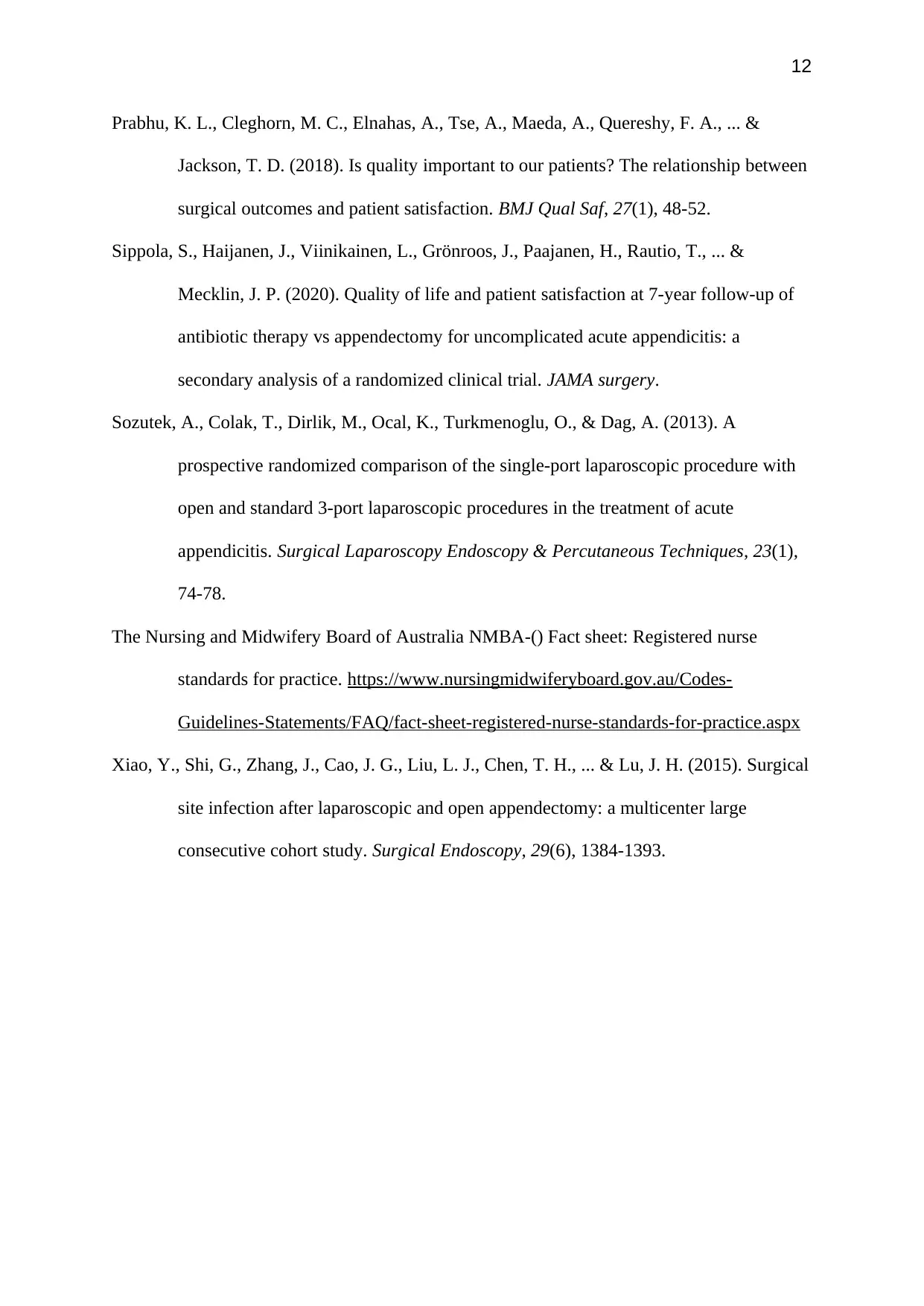
12
Prabhu, K. L., Cleghorn, M. C., Elnahas, A., Tse, A., Maeda, A., Quereshy, F. A., ... &
Jackson, T. D. (2018). Is quality important to our patients? The relationship between
surgical outcomes and patient satisfaction. BMJ Qual Saf, 27(1), 48-52.
Sippola, S., Haijanen, J., Viinikainen, L., Grönroos, J., Paajanen, H., Rautio, T., ... &
Mecklin, J. P. (2020). Quality of life and patient satisfaction at 7-year follow-up of
antibiotic therapy vs appendectomy for uncomplicated acute appendicitis: a
secondary analysis of a randomized clinical trial. JAMA surgery.
Sozutek, A., Colak, T., Dirlik, M., Ocal, K., Turkmenoglu, O., & Dag, A. (2013). A
prospective randomized comparison of the single-port laparoscopic procedure with
open and standard 3-port laparoscopic procedures in the treatment of acute
appendicitis. Surgical Laparoscopy Endoscopy & Percutaneous Techniques, 23(1),
74-78.
The Nursing and Midwifery Board of Australia NMBA-() Fact sheet: Registered nurse
standards for practice. https://www.nursingmidwiferyboard.gov.au/Codes-
Guidelines-Statements/FAQ/fact-sheet-registered-nurse-standards-for-practice.aspx
Xiao, Y., Shi, G., Zhang, J., Cao, J. G., Liu, L. J., Chen, T. H., ... & Lu, J. H. (2015). Surgical
site infection after laparoscopic and open appendectomy: a multicenter large
consecutive cohort study. Surgical Endoscopy, 29(6), 1384-1393.
Prabhu, K. L., Cleghorn, M. C., Elnahas, A., Tse, A., Maeda, A., Quereshy, F. A., ... &
Jackson, T. D. (2018). Is quality important to our patients? The relationship between
surgical outcomes and patient satisfaction. BMJ Qual Saf, 27(1), 48-52.
Sippola, S., Haijanen, J., Viinikainen, L., Grönroos, J., Paajanen, H., Rautio, T., ... &
Mecklin, J. P. (2020). Quality of life and patient satisfaction at 7-year follow-up of
antibiotic therapy vs appendectomy for uncomplicated acute appendicitis: a
secondary analysis of a randomized clinical trial. JAMA surgery.
Sozutek, A., Colak, T., Dirlik, M., Ocal, K., Turkmenoglu, O., & Dag, A. (2013). A
prospective randomized comparison of the single-port laparoscopic procedure with
open and standard 3-port laparoscopic procedures in the treatment of acute
appendicitis. Surgical Laparoscopy Endoscopy & Percutaneous Techniques, 23(1),
74-78.
The Nursing and Midwifery Board of Australia NMBA-() Fact sheet: Registered nurse
standards for practice. https://www.nursingmidwiferyboard.gov.au/Codes-
Guidelines-Statements/FAQ/fact-sheet-registered-nurse-standards-for-practice.aspx
Xiao, Y., Shi, G., Zhang, J., Cao, J. G., Liu, L. J., Chen, T. H., ... & Lu, J. H. (2015). Surgical
site infection after laparoscopic and open appendectomy: a multicenter large
consecutive cohort study. Surgical Endoscopy, 29(6), 1384-1393.
⊘ This is a preview!⊘
Do you want full access?
Subscribe today to unlock all pages.

Trusted by 1+ million students worldwide
1 out of 12
Related Documents
Your All-in-One AI-Powered Toolkit for Academic Success.
+13062052269
info@desklib.com
Available 24*7 on WhatsApp / Email
![[object Object]](/_next/static/media/star-bottom.7253800d.svg)
Unlock your academic potential
Copyright © 2020–2025 A2Z Services. All Rights Reserved. Developed and managed by ZUCOL.





